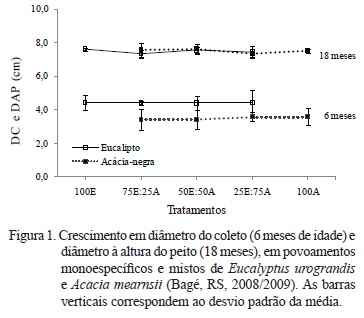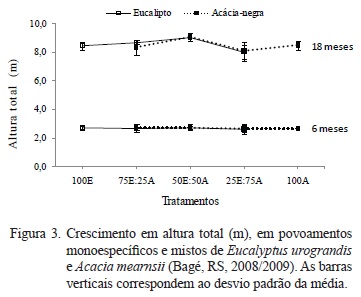Forest intercropping with nitrogen-fixing species can provide an increase in eucalyptus yield. The objective of this study was to evaluate growth and yield in monospecific and mixed stands of Eucalyptus urograndis and Acacia mearnsii, in Bagé, Rio Grande do Sul State, Brazil. Treatments were 100E (100% eucalyptus), 100A (100% black wattle), 50E:50A (50% eucalyptus + 50% black wattle), 75E:25A (75% eucalyptus + 25% black wattle), and 25E:75A (25% eucalyptus + 75% black wattle). The first evaluation was carried out at the age of 6 months (diameter at stem and total height) and the second at 18 months (diameter at breast height, total height, volume with bark, and leaf area index). The Eucalyptus urograndis and Acacia mearnsii diameter and total height growth, for both 6 and 18 months, did not differ among treatments. The total wood yield (m³ ha-1) was the same for cropping and intercropping, without any influence from other species. The mixed cropping system resulted in a greater number of individuals with higher diameters (μ + 1ѕ), when compared to the cropping system, offering the forester an opportunity to obtain multiple products from his/her forest, due to a greater assortment provided by the presence of the two species.
Eucalyptus urophylla S. T. Blake x Eucalyptus grandis Hill ex Maiden; Acacia mearnsii De Wild; forest intercropping; species interaction




